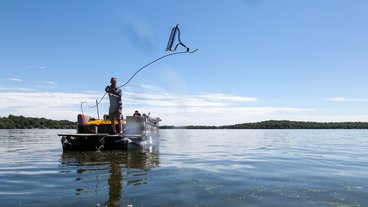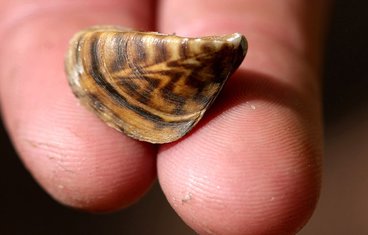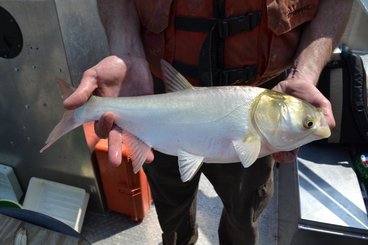
Some efforts against aquatic invasives switch from prevention to cure
Frustrated by the state Department of Natural Resource's lack of progress in combating invasive species, some local governments and lake associations are changing their focus from prevention to cure.
Among them is the Gull Chain of Lakes Association, which took the lead in the fight against invasive species in eight popular and highly developed lakes in the heart of cabin country north of Brainerd, Minn. After zebra mussels were found in Gull Lake in 2010, the association was the first to set up a decontamination station to clean boats to prevent the spread of zebra mussels.

Looking for a new method to fight invasive species
Fighting the spread of aquatic invasive species such as zebra mussels may move to a new battlefield.
Saturday, the Gull Chain of Lakes Association is expected to vote on a proposal to donate funds toward a new research and control program aimed at zebra mussels. It would be a change from early efforts the association put into preventing the spread of invasive species, which met with limited success.
Zebra mussels are small, fingernail-sized animals native to eastern Europe and western Russia.

Asian carp in Minnesota? If you net one, yes. But DNA won't tell
Were the Asian carp here or weren't they?
In 2011, alarms rang as researchers reported finding signs of silver carp well into Minnesota waters.
Then, last week, a new study revealed no evidence of the invasive fish's DNA anywhere in the the state, including those same waters.
So are the fish here?
The short answer is that no one can say for certain.

Carp DNA in Minnesota rivers turns out to be false alarm
Alarm bells went off in 2011 when wildlife researchers found surprising amounts of DNA from invasive carp in the St. Croix and Mississippi rivers and even above the Coon Rapids Dam.
Could the voracious fish already be here in large numbers? Could the DNA have come from the droppings of birds who had eaten the carp elsewhere? Or from illegally released baby carp used as bait?
None of the above, it turns out. It was a false alarm.

New test suggest Asian carp aren’t as prevalent as thought
Improved eDNA testing suggests that Asian carp, while occasionally netted in Minnesota waters, perhaps aren’t as prevalent as once believed.
A joint testing effort by the Minnesota Department of Natural Resources (DNR), the Minnesota Aquatic Invasive Species Research Center at the University of Minnesota (MAISRC), and U.S. Geological Survey failed to replicate 2011 testing results that showed positive hits for silver carp eDNA (genetic material from an organism found in the environment) upstream of the Coon Rapids Dam on the Mississippi River and elsewhere.

Study: Asian Carp Numbers Low in Minnesota
Researchers studying water samples from the Mississippi and St. Croix rivers for fragments of Asian carp DNA say they found little evidence of bighead and silver carp in Minnesota.
The study released Thursday concludes that while the invasive fish are present in Minnesota, their numbers are likely relatively low.

Study: No DNA evidence of Asian carp, could still breed in Minn.
A University of Minnesota report says the numbers of Asian carp in Minnesota are relatively low, but the invasive species may pose a problem in the future.
"I think they've got the potential to be very damaging to our ecosystems because they're a great big fish that feeds at the lowest part of the food chain and we don't have anything like that here," explained Steve Hirsch, of the Minnesota Department of Natural Resources.

Asian carp DNA not found in Mississippi, St. Croix rivers in Minnesota
The long-feared Minnesota invasion of two species of invasive carp apparently has not hit yet.
No DNA of silver and bighead carp, often referred to as Asian carp, was detected in the Mississippi or St. Croix rivers in Minnesota, according to a fresh analysis by federal, state and academic researchers, officials announced Thursday, April 4.
The fish still could be present, despite the lack of environmental DNA -- or eDNA -- officials cautioned. In fact, commercial fishing boats in Minnesota waters have caught live bighead carp. The fish are unlikely present in large numbers, officials said, but a leading researcher warned that he still believes the fish will eventually be able to breed here.

Study: No Evidence of Asian Carp DNA in Two Major Minnesota Rivers
New analyses for Asian carp DNA in water samples from the Mississippi and St. Croix rivers showed little evidence of bighead and silver carp, researchers announced in a report released today.
The joint effort by scientists from the new Minnesota Aquatic Invasive Species Research Center at the University of Minnesota, U.S. Geological Survey and the Minnesota Department of Natural Resources also concludes that while recent captures by commercial fisheries show these invasive fish are present in Minnesota, their numbers are likely still relatively low.

Few if any Asian carp in St. Croix, Mississippi rivers
Researchers say they have found little evidence of bighead and silver carp in the Mississippi and St. Croix rivers.
The latest research on Asian carp in the Mississippi and St. Croix rivers shows a small number of the invasive fish, but probably not a reproducing population. The research released on Thursday indicates that the invasive fish have not become established in Minnesota.
However, experts say the fish still pose an immediate threat in the two rivers.
